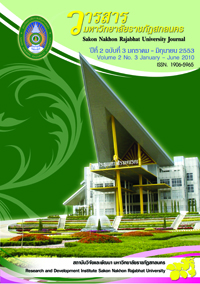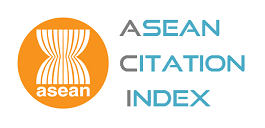การสร้างระบบตรวจสอบมาตรฐานสินค้า จังหวัดสกลนคร
Abstract
บทคัดย่อ
งานวิจัยนี้มีวัตถุประสงค์เพื่อสร้างมาตรฐานผ้าย้อมคราม สร้างความมั่นใจให้กับผู้บริโภค และขยาย ตลาดผลิตภัณฑ์ผ้าย้อมคราม เก็บข้อมูลโดยการประชุม สัมมนาผู้เกี่ยวข้องได้แก่ ผู้ผลิต ผู้แทนชุมชน ผู้บริโภค นักวิจัย นักธุรกิจ และผู้แทนจากหน่วยงานภาครัฐ ผู้แทนจากทุกหน่วยมีความเห็นตรงกันถึงความจำเป็นใน การสร้างมาตรฐานผ้าย้อมครามเพื่อความมั่นใจแก่ผู้บริโภค กลุ่มผู้ผลิตและชุมชนเห็นว่าไม่จำเป็นต้องเร่งสร้าง มาตรฐานแต่ควรเน้นการพัฒนาคุณภาพคนเพื่อนำไปสู่การพัฒนาคุณภาพผ้าจนเกิดวัฒนธรรม “ การสร้างผ้า ย้อมครามที่มีคุณค่าต่อชุมชน” ผู้ผลิตรวมถึงชุมชนเป็นผู้ควบคุม เฝ้าระวัง และสืบทอดบนพื้นฐานของความ เชื่อมั่นและไว้ใจกัน อีกทั้งสร้างความมั่นใจแก่ผู้บริโภคผ้าย้อมครามในบทบาทสินค้าชุมชน โดยคุณภาพคน เน้นที่ความซื่อสัตย์ มีคุณธรรม เข้าใจคุณค่าของผ้าย้อมคราม และรับผิดชอบต่อผลิตภัณฑ์ของกลุ่มด้วย สัญลักษณ์หรือตราสินค้า ส่วนกลุ่มนักวิจัยต้องเข้าใจในความยากของการควบคุมกระบวนการผลิตสีและการ ย้อมครามจากวัตถุดิบธรรมชาติด้วยภูมิปัญญาท้องถิ่น ขณะที่ผู้บริโภคต้องการผลิตภัณฑ์ธรรมชาติและ คุณธรรมจริยธรรมของผู้ผลิต ดังนั้นจึงไม่สามารถกำหนดมาตรฐานผ้าย้อมคราม ไม่มีหน่วยตรวจสอบและ รับรองดังเช่นสินค้าอุตสาหกรรมอื่น แต่ผู้เกี่ยวข้องได้ร่วมกันกำหนดมาตรฐานผ้าย้อมครามสกลนคร และ ยอมรับที่จะนำไปปฏิบัติ ดังนี้
1. ใช้วัตถุดิบจากธรรมชาติ ทั้งสีคราม เส้นใย และนํ้าขี้เถ้า
2. ย้อมด้วยการหมักเนื้อครามในน้ำขี้เถ้าตามวิธีของภูมิปัญญาท้องถิ่น
3. ใช้เครื่องมือทอผ้าพื้นบ้าน พัฒนาด้วยเทคโนโลยีพื้นบ้าน
4. ผ้าทุกผืนมีเอกลักษณ์ มีเรื่องราว
5. รักษาจิตวิญญาณของผู้ผลิตและชุมชนในความเอื้อเฟื้อ แบ่งปัน ทั้งกับชุมชนและสิ่งแวดล้อม
ส่วนมาตรฐานในระดับกว้างกว่า เช่น มาตรฐานผลิตภัณฑ์ชุมชน มาตรฐานผลิตภัณฑ์อุสาหกรรม ควรเป็นผลสืบเนื่องต่อไป
ABSTRACT
The purposes of this research were : 1) to establish the standards of indigo – dyed cloths, 2) to create consumers’ confidence, and 3) to extend indigo – dyed cloths’ market. The study revealed that all relevant parties which included the producers, representatives from the communities, consumers, business people, and representatives from the government offices had the same views on these matters. They agreed that it was essential to establish the standards of indigo – dyed cloths so as to create consumers’ confidence. As for the producers and representatives from the communities, they saw that there was no need to speed up the establishments of the standards and consumers’ confidence. On the contrary, they thought that there should be an emphasis on the quality of human resources who produced the indigo – dyed cloths. This would lead to the better quality of the cloths which ultimately would bring about a culture called “indigo – dyed cloths” production which is valuable to the community. To reach this cultural value, the producers and communities had to collaborate with each other in controlling , protecting and transferring the production procedure based on their confidence and trust. In addition, both the producers and the communities had to help create the confidence in the consumers by convincing them that these communities’ products which were made of indigo – dyed cloths were produced by quality people who possessed integrity, conscience, as well as appreciation of the indigo – dyed cloths. These people would be responsible for their group’s products by branding these goods with logos or trademarks. With regard to the researchers, they understood the procedures of producing the colors to dye the cloths from natural raw materials by adopting the local wisdom. These procedures were hard to control. In the mean time, the consumers showed their demands for natural products and the producers’ conscience and ethics. As the needs from the researchers and the consumers did not coordinate, the standards of indigo – dyed cloths could not be established. Thus, unlike other industries, there was no authorized supervisory agency which would check and approve the qualities of the products made from indigo – dyed cloths. However, all relevant parties had proposed the standards of Sakon Nakhon’s indigo – dyed cloths as the following:
1. All the indigo hues, fibers and lye ash water must be gained from natural raw materials.
2. The dyeing method must follow the local wisdom of immersing and fermenting the indigo plant and leaves tissues with the lye ash water.
3. All weaving tools must be produced and developed according to the local technology.
4. All cloths should contain uniqueness and story.
5. The cloths must maintain spiritual characters of the communities and producers’ generosity and sharing with their communities and environments.
As for the broader standards of community products, and industrial products, these standards should be resulted from the standards mentioned above.








